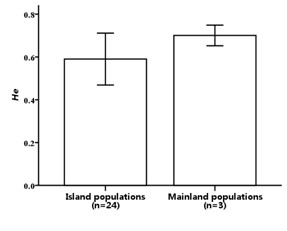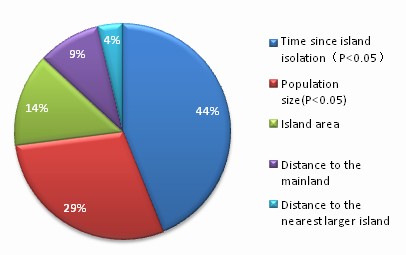Loss of genetic variation in small populations that have been isolated for prolonged periods of time may compromise fitness and evolutionary potential and also make such populations more susceptible to extinction. These possibilities have been the focus of intense investigation in conservation biology. Understanding the factors responsible for loss of genetic variation is crucial for managing fragmented populations in the wild. Island systems provide ideal natural experiments for testing hypotheses about population genetics and evolution and the effects of fragmentation on genetic diversity loss in wild populations. Globally, most studies of genetic diversity on archipelagoes have focused mainly on America, Australia, the Mediterranean Sea and Europe. There has been relatively less focus on Asia. Diversity and Spatial Ecology Research Group used nine microsatellite markers to quantify genetic diversity and differentiation of 810 pond frogs (Pelophylax nigromaculatus) from 24 islands of the Zhoushan Archipelago and three sites on nearby mainland China, and estimated the effects of the island area, population size, time since island isolation, distance to the mainland and distance to the nearest larger island on reduced genetic diversity of insular populations.
The results showed that the mainland populations displayed higher genetic diversity than insular populations (Fig 1). Genetic differentiations and no obvious gene flow were detected among the frog populations on the islands. A Pearson correlation analysis indicated that the genetic diversity of the insular populations was positively correlated with island size (log transformed), population size (log transformed) but negatively with time since island isolation (square root transformed). Furthermore, hierarchical partitioning (HP) analysis showed that only time since island isolation and population size significantly contributed to insular genetic diversity (Fig 2). These results suggest that decreased genetic diversity and genetic differentiations among insular populations may have been caused by random genetic drift following isolation by rising sea levels during the Holocene (the last 10,000 years). The results provide strong evidence for a relationship between retained genetic diversity and population size and time since island isolation for pond frogs on the islands, consistent with the prediction of the neutral theory for finite populations. This study highlights the importance of the size and estimated isolation time of populations in understanding the mechanisms of genetic diversity loss and differentiation in fragmented wild populations.
This study has been published in Molecular Ecology on February 2014 (http://onlinelibrary.wiley.com/doi/10.1111/mec.12634/full). The first author of the paper is Drs. Supen Wang, and Professor Yiming Li is the corresponding author. The study is funded by the National Natural Science Foundation of China (31172111).

Fig 1. Genetic diversity of island populations as compared to related mainland populations

Fig 2. Variations in insular genetic diversity (He) explained by factors in Hierarchical partitioning analysis.


